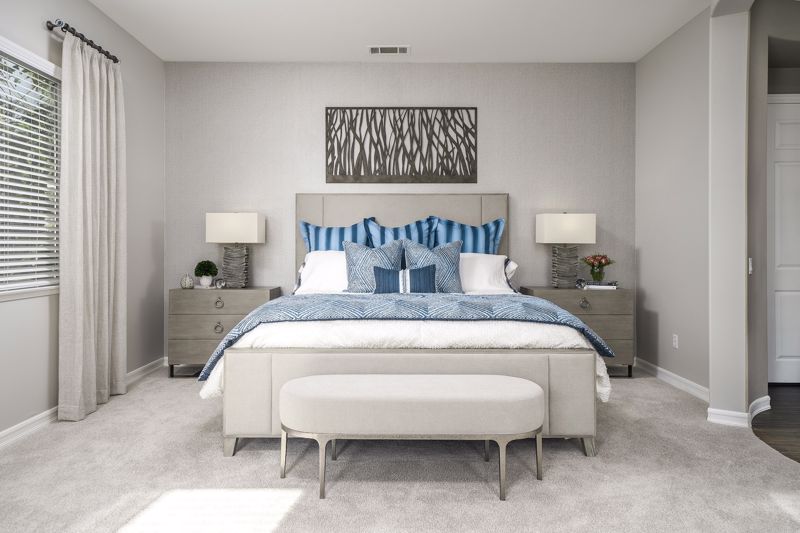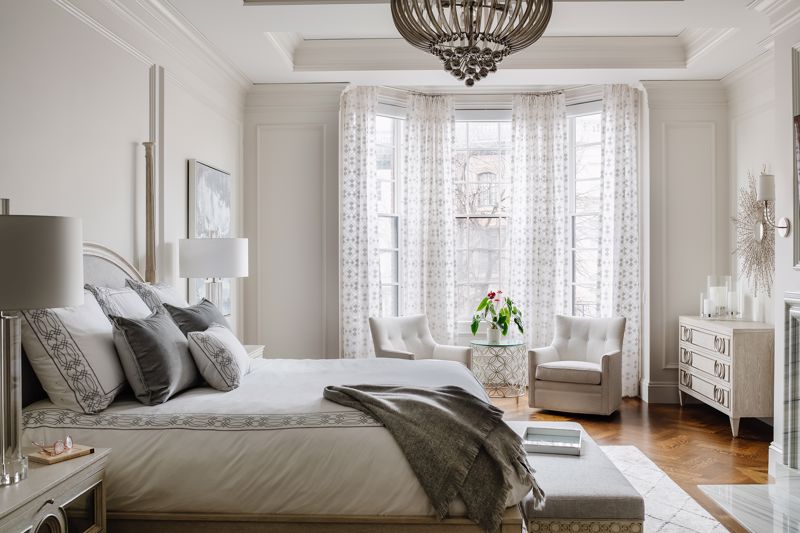Master Bedroom Layout Ideas for a Relaxing and Functional Space
The amount of sleep you get each night is extremely important, and your bedroom layout may have more impact on this total than you might think. By creating a relaxing oasis away from the stresses of life, you can rest more soundly and wake feeling refreshed.
Is your master bedroom cluttered or in need of some restructuring? Don't sweat it! Here are some bedroom layout ideas to inspire you.
Optimal Furniture Arrangement

Bed Placement
The bed is the focal point of your master suite — it's called a bedroom for a reason. Start with the bed placement and base everything else off of that. Generally, it's best to have it pushed against the wall opposite the door, drawing people's attention right as they enter the room. This makes it the focal point and a central axis your room's interior design can orbit around.
A good rule of thumb is to have the bed centered on the wall rather than shoved in a corner. This creates a parallel structure and gives off a luxurious, open bedroom feel. Think of a nice hotel room or your favorite Airbnb; these stays generally have the bed placed in the middle of the furthest wall. This setup is a great place to start if you're going for a room that feels like a five-star suite.
If you don't know what wall to put your bed against, you can also take a cue from your home's architecture. There's no wrong way to arrange your room, but often an architect designs a room to fit pieces a particular way. For example, if you have a home with exposed brick on one wall, this could be a nice bed placement. Or, if you have a long bedroom, try putting the bed further to one side of the room rather than in the center to split the area into two functional spaces.
Nightstand and Bookshelf Arrangement
After the bed has a home, think about how you naturally use the space. What furniture pieces would make this room easy to move around and function in? This could include a nightstand on either side of the bed frame so you can plug in your phone at night or easily turn on a table lamp to read before going to sleep.
You may also want a bookshelf within reach if you're a reader. You could have it in the corner so you easily grab your favorite novel. Or, you can create a book nook on the opposite side of your room if there's space available.
Clothing Storage
Do you have ample closet space? If so, you probably don't need a dresser. However, if you do need a bit more bedroom storage, a dresser or bureau is a solution that's both stylish and functional. Placing your dresser on the wall opposite your bed often works best. You can use the top of this furniture piece to showcase family pictures, vacation souvenirs, your most-worn jewelry pieces and perfume or any other items you'd like to see first thing in the morning.

Seating
Have a floor plan with extra space and aren't sure what to use it for? A seating area with a sofa, lounge chaise or plush chair can offer an extra place to escape to at the end of a long day. This works great for the longer rooms we previously mentioned. If you have an awkward open area that makes the room look a little off, put a comfortable seating arrangement and a small table or ottoman. Like your living room, a designated seating area makes a special area for you to kick your feet up — but from the privacy of your own space.
Home Office
For rooms with a small alcove, you can create a home office set up with a desk, mirror and lamp. Whether you use this to get things done from your room or simply get ready for work, it can be a wonderful addition to any bedroom space and make your morning routine a breeze.
Color and Lighting
With the right furniture and layout, any space can transform from drab to fab. However, lighting fixtures and colors can help those pieces shine. Here are some tips for getting the most out of your bedroom layout and style:
Use Natural Light
Take advantage of natural light by capitalizing on any windows you may have in your bedroom. Either place the seating area right below it or make it a beautiful light to wake up to first thing in the morning. To accomplish this, ensure your bed frame isn't on the same wall as the window.
As for draperies, you have a wide selection of textiles, patterns and colors to choose from. If you want to block out any outside lights at night and regulate the temperature in your room, thick, darkening window treatments will do the trick. If you want to capitalize on the bright rays of sunlight, linen or cotton draperies will be more your style.
Light Up the Bedroom Space With Lamps
In addition to natural light, it's also important to have lamp fixtures for when the sun sets. Place them near areas that you'll frequently use, creating a more ambient, relaxing space than using the bright overhead light. Common placement options include on your bedside table, in the corner by your seating area, atop your dresser and near your desk.
It also helps to have an overhead light in addition to your lamps. Just be sure to select one that doesn't hang too low to the ground or seem like the wrong size for the space. If you want to completely steer clear of overhead lighting, you can choose a wall sconce instead. Stylish options can make any room instantly chicer, even if your room doesn't need a ton of extra lighting.
Select Soothing Colors
When done correctly, light and color can work together to harmonize your room. Many experts believe blue is the best color to paint a primary bedroom due to its calming effects. Additionally, green and gray help people sleep better because of their connotations with nature. On the other hand, neon and bright colors can have the reverse effect, making it difficult to catch those all-important siestas.
One item to note is the natural light streaming through your windows will impact your room's color. If the sun is bright enough, it can wash out light colors, making them appear off-white. When selecting a hue, it can be helpful to look at the paint swatch in the sun to determine if the color will work well in brightly lit spaces.
Other Bedroom Layout Tips: Honorable Mentions
Outside of furniture layout, lighting and color selection, there are still a few best practices to follow for an optimal bedroom design:
- Small bedroom layout: If you have a little master suite, don't be afraid to bend the rules a little to make the small space work for you. For example, if your bed looks best pushed into a corner, leave it there! You don't have to center it if it makes your room uncomfortable or tight.
- Feng shui bedroom layout: If you want a minimalist space that follows the rules of feng shui, limit the number of books, electronics, house plants or general items that aren't considered a necessity. While this isn't a must, it can help your space appear more soothing.
- Comfortable items: The ultimate haven should be comfortable. This means including plush area rugs, throw blankets and pillows that match the aesthetic and color scheme of your space.
Get Help From a Professional
Even with the best inspiration to go off of, getting your bedroom exactly how you want can be challenging. That's why Decorating Den Interiors has decorators ready and available to make your layout dreams come true. We've worked with every style of space, from massive accommodations to small, awkwardly shaped bedrooms — creating a true pinch-me moment for each of our clients as we reveal the final work.
Ready to transform your bedroom design with the help of a Decorating Den Interior designer? Find a decorator near you today.

